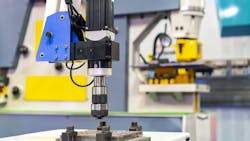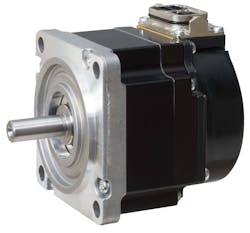How Advanced Servo Technology can Take Motion Systems to the Next Level
In the fast-paced landscape of motion system technologies, servos are indispensable components in applications that need to deliver accuracy, precision and dynamism. With the increased adoption of data-driven smart manufacturing applications, motion control systems are undergoing substantial changes. Shop floors are shifting from older more basic servo products and basic analog controllers towards more responsive, efficient, and advanced digital solutions that utilize multi-axis servo-motor actuators for precise position, speed, and torque control.
The latest developments in sensing, artificial intelligence (AI) and industrial automation are also expanding the capabilities of motion control devices, offering new opportunities and potential for further advancement.
For example, the most sophisticated servos can seamlessly synchronize a multitude of axes to carry out complex yet highly coordinated movements while maintaining extremely short cycle times in the microsecond range. As a result, it is possible to implement cutting-edge, value-adding machines that can achieve remarkable speed while delivering consistent, repeatable, high-quality results to maximize productivity and throughput.
Integrated Intelligence Leads to Improved Motion Control
Looking at these trends, it is clear to see how the evolution of servos is marked by a distinct progression toward enhancing speed, repeatability, and data processing capabilities. Beyond faster data sharing and enhanced processing, the integration of intelligent algorithms is becoming key.
These are not just responsive – they are anticipatory, effectively mitigating disturbances, such as vibrations and harmonics, that could impede the flawless execution of motion operations. More precisely, they ensure that motion remains swift as well as remarkably precise, eliminating deviations and irregularities that might compromise the integrity of processes.
Greater speed and responsiveness for today’s drives goes beyond operational performance. They support installation and startup by enhancing their user-friendliness through simplified programming, pre-coded functions as well as auto-tuning capabilities. Even more, they can effectively self-regulate. For instance, using automated position control and adjustment, the system itself can keep tabs on the required motion through closed-loop feedback systems.
Similarly, functions for servo gain adjustment contribute to reduced settling time while controlling overshoot and vibration suppression. For example, some servo drives can automatically generate all the gain values within approximately 0.3 seconds. In addition to ensuring consistent performance while minimizing downtime and maintenance, users can benefit from optimized energy use as well as quieter operations.
Machine wiring is also simplified, with a single cable to connect encoders, power and electromagnetic brakes, as well as one-touch lock connectors to avoid screw tightening. Reducing installation time, costs and the bill of materials, these features can help drive profitability and agility within a business.
Data Brings Servo Performance to New Heights
The most ambitious servo drives offer even more. They transcend basic operations, incorporating more data-based features to enhance productivity, reliability and responsiveness.
A premier example is the use of AI for condition monitoring and predictive maintenance. Thanks to embedded sensors continuously generating real-time data that communicate with prognostic models to detect wear, it is possible to identify anomalies and intervene well before critical issues occur.
In effect, users can benefit from an up-to-date accurate overview of the status of their motion system as well as leverage a setup that recommends timely actions based on the condition of the components. Therefore, they can move away from reactive maintenance or pre-set, non-indicative schedules. This means emergency shutdowns and downtime, especially unplanned, can be minimized, if not eliminated, while optimizing equipment service life, avoiding the replacement of healthy components.
This approach minimizes disruptions, enhances efficiency and significantly contributes to cost savings.
READ MORE: Understanding How to Test and Repair Servo Motors
The Importance of Choosing the Right Communication Technology
As most of the functions described require high-speed data sharing, equipping servos with the right communication technology is fundamental to supporting all these groundbreaking capabilities and unlocking the full potential of motion systems. To meet modern, data-hungry applications, machine builders and end users should favor servos that leverage high-performing industrial Ethernet technologies.
What once worked at 10 Mbps is now a relic in terms of technology and capability, with forward-looking businesses relying on 100 Mbps and even 1 Gbps solutions. This increased bandwidth is fundamental to developing competitive setups for data-intensive operations.
In addition to bandwidth, using a network technology with Time-Sensitive Networking (TSN) functions is beneficial as it enables highly reliable, deterministic communications between devices sharing different types of traffic. This sets the stage for comprehensive Industrial Internet of Things (IIoT) environments where diverse data can seamlessly converge to support motion control and data-driven decision-making processes, such as predictive maintenance.
READ MORE: Advancing Motion Control in Industrial Printing Machines with TSN
Finally, choosing servos that use an open, vendor-neutral network technology can help the creation of value-adding systems. Proprietary solutions can limit users in the specification of industrial automation components, as they may have to rely on products belonging to a single vendor's ecosystem. More interoperable alternatives grant system integrators and end users the flexibility to choose the solutions that precisely align with their requirements.
Future-oriented servos embracing an advanced open network technology that combines gigabit bandwidth and TSN functions, such as CC-Link IE TSN, are key elements within highly competitive motion systems. By choosing drives that include these features, end users are not just investing in machinery but advancing in their digital transformation journey toward data-driven operations that offer increased performance, efficiency and competitiveness.
This article was written and contributed by Tom Burke and Roy Kok of the CC-Link Partner Association (CLPA) Americas which aims to provide collaboration on industrial network connectivity worldwide.
About the Author
Roy Kok
Senior Partnerships and Alliance Specialist, CC-Link Partner Association
Roy Kok is the Senior Partnerships and Alliance Specialist at the CC-Link Partner Association (CLPA) Americas.
Thomas J. Burke
Global Strategic Advisor for the CC Link Partner Association (CLPA)
Thomas J. Burke is Global Strategic Advisor for the CC Link Partner Association (CLPA) which aims to provide collaboration on industrial network connectivity worldwide.
In addition, Tom serves as Global Director of Industry Standards for Mitsubishi Electric to lead the strategic development and adoption of networking standards, including the adoption of Mitsubishi Electric’s open networks solutions. Tom is also the Global Directory of Industry Partnerships for ICONICS, providing leadership to increase market share of ICONICS’ leading-edge product portfolio.
Tom’s background includes being the former OPC Foundation President & Executive Director and pioneered the OPC Unified Architecture (OPC UA) as the foundation of information integration and interoperability.
He has a bachelor’s degree in theoretical mathematics from John Carroll University (Cleveland, OH), and a master’s degree in computer engineering from the University of Dayton (Dayton, OH).

Leaders relevant to this article:



